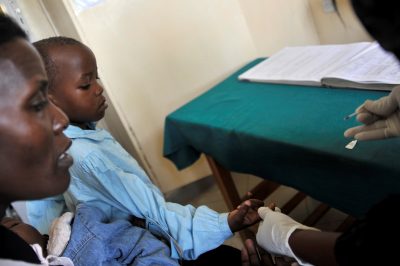The new, rapid diagnostic test (RDT) for malaria is easier and quicker than the old microscopy laboratory test.

The Rapid Diagnostic Test (RDT) is easy to use for health care workers and creates a faster, more tolerable experience for Kenyans who come to get tested for malaria.
The Nyalunya Dispensary in Kisumu is quiet today – about 25 patients are waiting to be served by the three health care workers on duty. Noline Anyango, 2, and her four-year-old sister are being tested for malaria by a laboratory technician. Noline doesn’t shed a tear as her index finger is pricked. The entire process only takes a few minutes – and Noline and her family are dismissed to the reception area to wait for their results – which will take about 20 minutes.
The new, rapid diagnostic test (RDT) for malaria is “easier and quicker than the old microscopy laboratory test,” says health care worker Christine Musechi – as she prepares another test kit. She says “the kits make it possible to diagnose and treat twice as many patients a day compared to microscopy.”
While both tests use a drop of the patient’s blood to confirm a malaria diagnosis – microscopy requires microscopic examination of blood by specialized personnel, such as a lab technician, and can often take hours. A shortage of lab personnel has also been a challenge to the health sector in the past.
The rapid diagnostic test is a device that displays a colored line if it detects a malaria antigen and results take 5 – 20 minutes. An additional advantage of the rapid diagnostic test is that it does not require specialized skills to use.
In 2012, based on global recommendations – the Government of Kenya adopted a policy of universal diagnosis. This policy required that every patient with suspected malaria must be confirmed with a diagnostic test before they are treated. The rapid diagnostic test makes following these regulations practical and possible.
Before the policy was introduced, health workers would clinically diagnose and treat the disease based only on the symptoms due to a shortage of specialized personnel, or long wait times. Headache, fever, chills – all of these are common symptoms of malaria. They are also common symptoms of tuberculosis and a host of other infections.
The misdiagnosis of malaria bears a heavy health care cost – both to the patient and the nation. “When a person is misdiagnosed and given the three day malaria treatment – they will inevitably return to the clinic with symptoms far worse than before,” says Emmah Obegi, Kisumu East District Pharmacist. It is estimated that over 170 million working days in Kenya are lost each year because of malaria illness.
By scaling up the use of the rapid diagnostic tests, the Government of Kenya will also save valuable health resources by eliminating the unnecessary use of malaria medications. These resources, can perhaps “be used to treat other diseases like HIV or typhoid – which are both major health issues,” adds Obegi.
USAID provided support to the Division of Malaria Control in determining the quantities of kits needed and developing a national rollout plan to efficiently distribute and manage the tests. USAID also helped train over 3,200 health care workers on the use of the kits.
Areas like Nyanza – where malaria prevalence is high – were given priority in the rollout plan and tests are now widely available in these regions. Eight million test kits were procured in 2012, with another 11 million slated for 2013. In the past, malaria diagnostic tools were reserved for hospitals and large health facilities. Today, rapid diagnostic tests have made their way to small, rural public and faith based healthcare facilities like the Nyalunya Dispensary.
A quick scan of the daily activity register and the malaria prevalence in Nyanza County becomes evident – with over half of the persons tested at the dispensary over the last few days confirming positive. Malaria is one of the leading causes of illness and death in Kenya – and is the biggest killer of children under five. Over three-fourths of Kenyans live in malaria risk areas where the disease is transmitted.
One by one, as patients test positive – Christine logs their names, ages and results in the thick daily activity register book. With improved methods of diagnosis and diligent record-keeping, “the Government of Kenya now has evidence-based estimates for the procurement of anti-malarial drugs,” explains Obegi. Saving money on a surplus of malaria treatments previously wasted on misdiagnosis means that Kenyans will only be treated for malaria when they have it – which Obegi thinks is by far the best health care solution.
